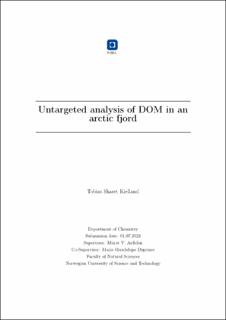| dc.contributor.advisor | Ardelan, Murat V | |
| dc.contributor.advisor | Digernes, Maria Guadalupe | |
| dc.contributor.author | Kielland, Tobias Skaret | |
| dc.date.accessioned | 2022-10-27T17:20:03Z | |
| dc.date.available | 2022-10-27T17:20:03Z | |
| dc.date.issued | 2022 | |
| dc.identifier | no.ntnu:inspera:109833569:32950803 | |
| dc.identifier.uri | https://hdl.handle.net/11250/3028723 | |
| dc.description.abstract | Arktis er et complexed økosystem system under raskt endring.
takket være global oppvarming er forståelsen for de kjemiske egenskapene til denne regionen uunnværlige.
Denne studien tar for sesongendringene av vannløst organisk materiale (DOM). Prøvene ble tatt i Ramfjoden på to stasjoner, en indre og en ytre.
Begge med to dybder, 5m og 30m. Analysen av disse prøvene ble gjort for vannløst organisk karbon (DOC) ved bruk av en NPOC-analysator og DOM ble ekstrahert
ved bruk av fast fase ekstraksjon og analysert med orbitrap massespektroskopi.
DOC resultatene viste høyere verdier om våren og høsten, med det høyeste resultatet på
våren, meg 3,30 mg/L. DOM-prøvene viseste tydelige kjemiske endringer i mars, mai, juni og oktober. Med tannin, protein og kondensert
aromatisk -lignende forbindelser, som de sterkeste indikatorene på denne kjemiske endringen.
Mens lignin-lignende forbindelser ble vist å være den største fraksjonen av forbindelsene
i vannsøylen, i tillegg til å ha en negativ korrelasjon med tannin. totalbilde tilsier at fjord DOM et komplekst system som en rekke ulike faktorer. | |
| dc.description.abstract | The Arctic Ocean is system that is quickly being altered due to climate change.
Understanding the chemical properties of this region is essential in these times.
In this study, the seasonal changes of dissolved organic matter (DOM) are looked
at. The samples were taken in Ramfjoden at two stations, an inner and an outer,
both with two depth, 5m and 30m. Furthermore the analysis was for done dis-
solved organic carbon(DOC) using an NPOC analyser and DOM was extracted
using solid phase extraction and analysed with orbitrap mass spectroscopy. The
DOC showed higher values in spring and autumn, with the highest being in
spring, at 3.30mg/L. The DOM samples show distinct chemical changes hap-
pening in March, May, June and October. With tannin, protein and condensed
aromatic -like compounds being the strongest indicators of this chemical change,
while Lignin-like compounds were shown to be the larges fraction the compounds
in the water column and a negative correlation with tannin. Over all this in-
dicates a complex system of which a multitude of different factors such spring-
bloom, melt water and other, alter the chemistry of the water column and provide
the basis for marine life. | |
| dc.language | eng | |
| dc.publisher | NTNU | |
| dc.title | Untargeted analysis of DOM in an arctic fjord | |
| dc.type | Master thesis | |
